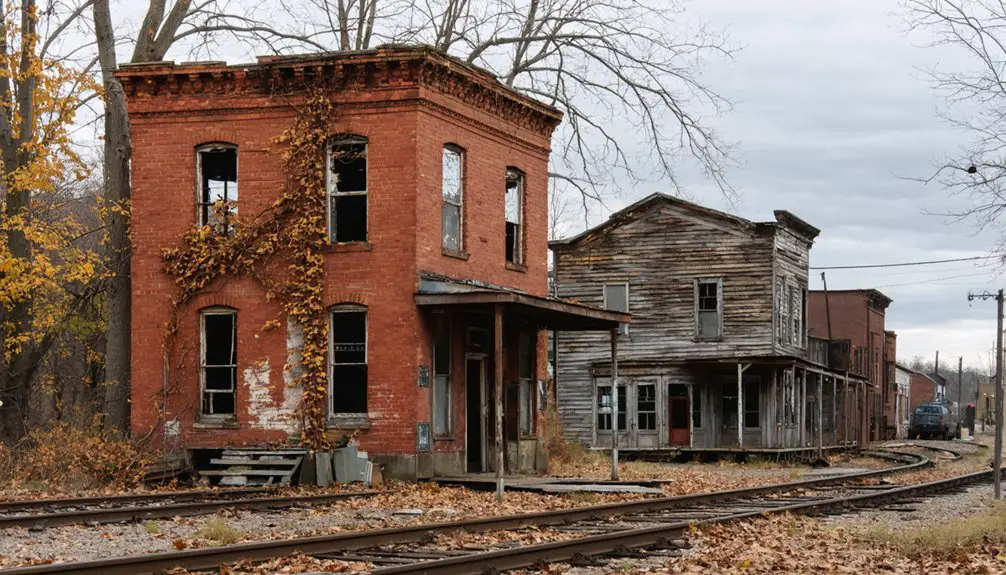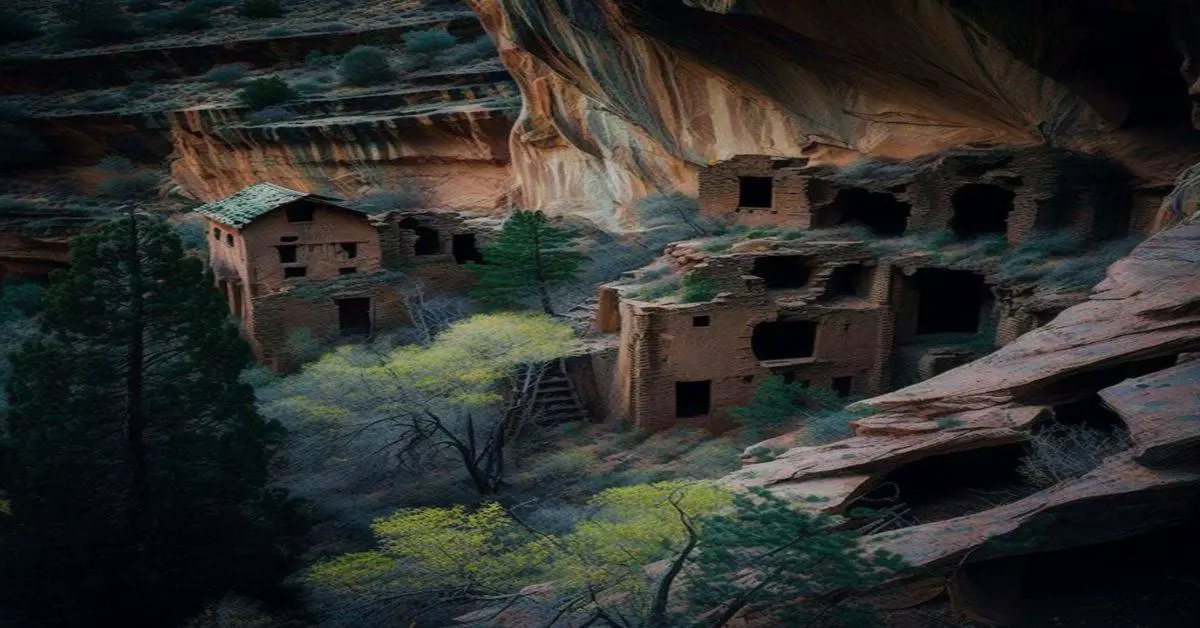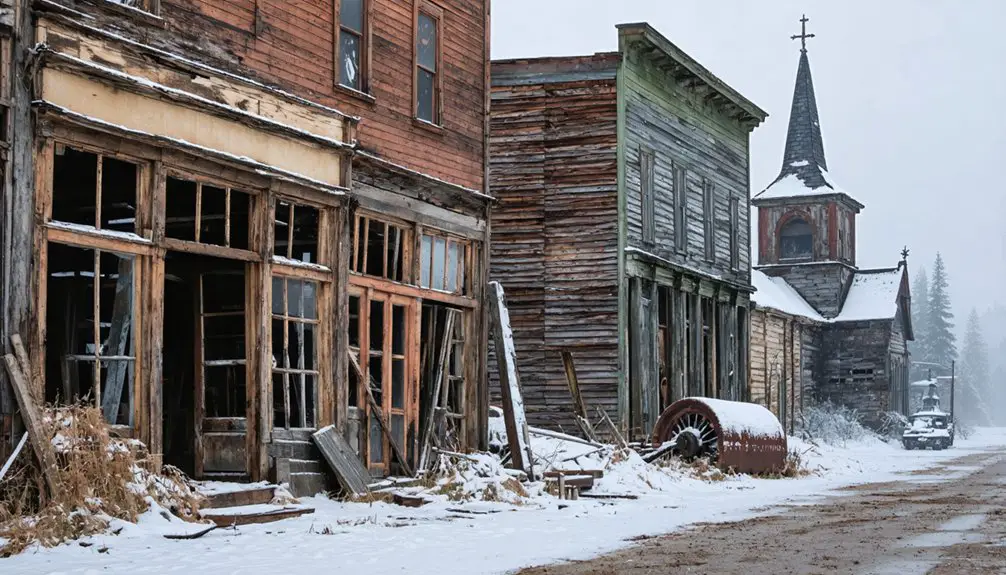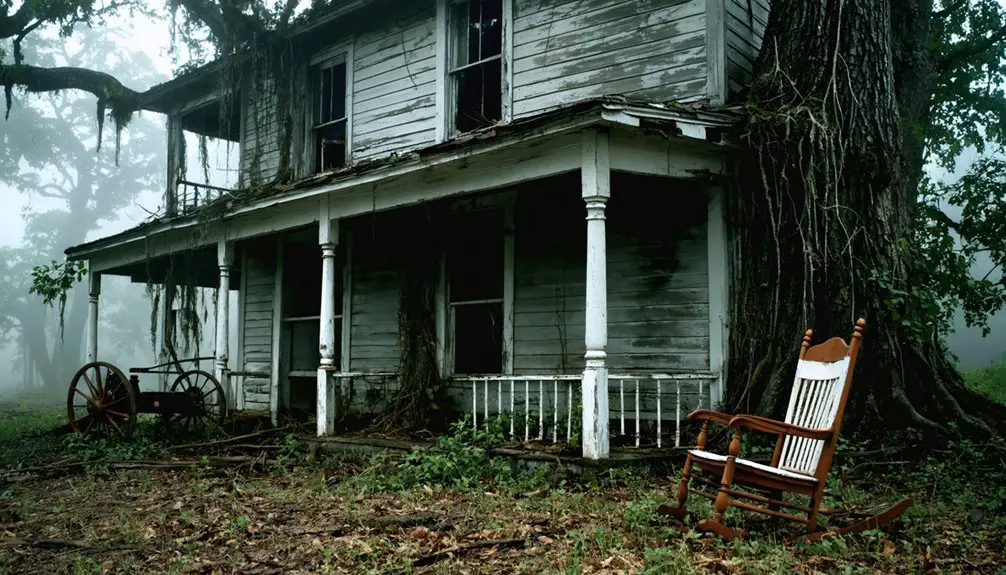You’ll discover a remarkable ghost town nestled in West Virginia’s New River Gorge, where Thurmond once processed more freight than Cincinnati and Richmond combined. In its 1920s heyday, this bustling railroad hub hosted 15 daily passenger trains and wild nightlife centered around the infamous Dun Glen Hotel. Today, the National Park Service preserves over 20 original structures, including the 1904 depot that still serves Amtrak. The town’s weathered buildings hold countless untold stories of America’s industrial past.
Key Takeaways
- Thurmond was a booming railroad town in West Virginia that became nearly abandoned after diesel locomotives replaced steam engines in the 1960s.
- The town’s population declined from over 500 residents during its peak to fewer than 5 permanent residents today.
- The National Park Service preserves over 20 original structures, including the historic C&O Railroad depot which serves as a visitor center.
- The town remains accessible by Amtrak’s Cardinal line and attracts tourists interested in exploring authentic American railroad heritage.
- Once handling more freight than Cincinnati and Richmond combined, Thurmond now stands as a preserved ghost town within New River Gorge.
The Birth of a Railroad Empire
When William D. Thurmond acquired 73 acres along the Chesapeake & Ohio Railway in 1873, he’d set the stage for one of America’s most significant railroad expansion stories.
You’ll find the town’s strategic placement wasn’t accidental – it served as an essential junction where coal-rich New River Gorge mines connected to C&O’s mainline. The town quickly became a major revenue producer for the railway system.
The completion of the Southside Junction bridge in the late 1880s transformed Thurmond into a booming transportation hub.
From Boom to Bust: Thurmond’s Golden Age
During the town’s golden age in the early 1900s, you’d find Thurmond’s railroad depot bustling with fifteen daily passenger trains that brought 95,000 travelers annually through this economic powerhouse.
The town was officially incorporated in 1901 as its rapid growth and development continued to shape the region.
You could witness more freight passing through Thurmond than Cincinnati and Richmond combined, while the town’s banks grew to become some of West Virginia’s wealthiest institutions.
The stark contrast between Thurmond’s alcohol-free main street and the neighboring Dun Glen Hotel’s legendary poker games and wild parties painted a fascinating picture of this railroad boomtown’s dual nature.
The steam engine shop played a crucial role in maintaining the town’s railroad operations and contributed significantly to its economic success.
Railroad Hub Prosperity
Thanks to Captain William D. Thurmond‘s strategic purchase of 73 acres along the C&O Railway in 1873, you’d witness the birth of one of America’s most significant railroad hubs.
The town’s railroad significance skyrocketed after the Southside Junction bridge opened in the late 1880s, connecting the main line to the rich New River coalfields.
You’d have seen Thurmond’s rail yard bustling with 150-200 workers manning the extensive maintenance shops, coaling stations, and repair facilities. During its peak, the station served an impressive 15 passenger trains daily.
The scale of coal transportation through this small town was staggering – Thurmond handled more freight tonnage for C&O than Cincinnati or Richmond.
With wholesale fruit, meat, and grocery distributors establishing operations alongside banking and telegraph services, you’d have found a thriving commercial center that outpaced nearby county seats like Fayetteville and Beckley.
Wild Nightlife Culture
The notorious Dunglen Hotel stood as the epicenter of Thurmond’s wild nightlife from 1901 to 1930, transforming this bustling railroad hub into a playground for wealthy coal barons and high-stakes gamblers.
You’d find lavish parties in the elegant ballroom, where symphonies played until dawn while the world’s longest poker game ran continuously for 14 years.
Despite local prohibition, the hotel’s bars flowed freely, creating rich nightlife folklore of vice characters who defied Captain Thurmond’s strict moral code.
Just outside town limits in Ballyhack, saloons and gambling houses catered to miners and railroad crews. The massive influx of wealth from the coal industry boom fueled the nonstop revelry.
Fifteen passenger trains arrived daily, bringing fresh waves of revelers seeking adventure and fortune in this mountain boomtown.
The rivalry between Thurmond and McKell shaped distinct vice zones, where illegal revelry thrived until the Dunglen’s destruction by arson in 1930 marked the beginning of the town’s decline.
Life in a Wild West Coal Town
Life sprang up around Thurmond’s bustling rail yards in the late 1800s, as coal mining transformed this remote West Virginia town into an essential industrial hub.
A rustic Appalachian town transformed into a vital junction, where coal and commerce collided amid steam and steel.
The ghostly whispers of forgotten stories still echo through what was once a thriving epicenter of American industry, where you’d find:
- Fifteen passenger trains daily shuttling 75,000 travelers through the depot annually
- Some of West Virginia’s wealthiest banks, flush with coal baron money
- 150-200 railmen working round-the-clock keeping coal flowing to power America
- Hotels and saloons packed with miners, travelers, and railroad workers
You’d witness wholesale produce arriving by rail, orchestras performing for entertainment, and constant activity as coal from surrounding mines like Oswald and Price Hill fueled the nation’s factories, ships, and cities.
At its peak, Thurmond shipped an astounding 4 million tons of coal and lumber annually, generating massive wealth for the region.
The town’s prosperity continued until the Siltex Mine closure in the 1980s marked the end of an era for this once-bustling coal town.
The Notorious Dun Glen Hotel Saga
Among Thurmond’s most intriguing tales stands the saga of Dun Glen Hotel, a four-and-a-half-story monument to vice and luxury that helped earn the town its reputation as the “Dodge City of the East.”
Built in 1901 by Thomas G. McKell, this lavish establishment became the epicenter of gambling culture, hosting the world’s longest continuous poker game – an astounding 14-year marathon. The hotel’s opening night gala featured an orchestra from Cincinnati performing for the region’s elite.
While Thurmond proper remained dry, you’d find alcohol flowing freely at Dun Glen’s continuously operating bar. For $2.50 a night, you could stay where coal barons sealed million-dollar deals and high-stakes gamblers won fortunes.
Dun Glen’s legacy lives on through stories of its famous orchestra performances, fresh seafood served on fine china, and its dramatic end by arson in 1930, marking the beginning of Thurmond’s decline.
Architectural Heritage Frozen in Time
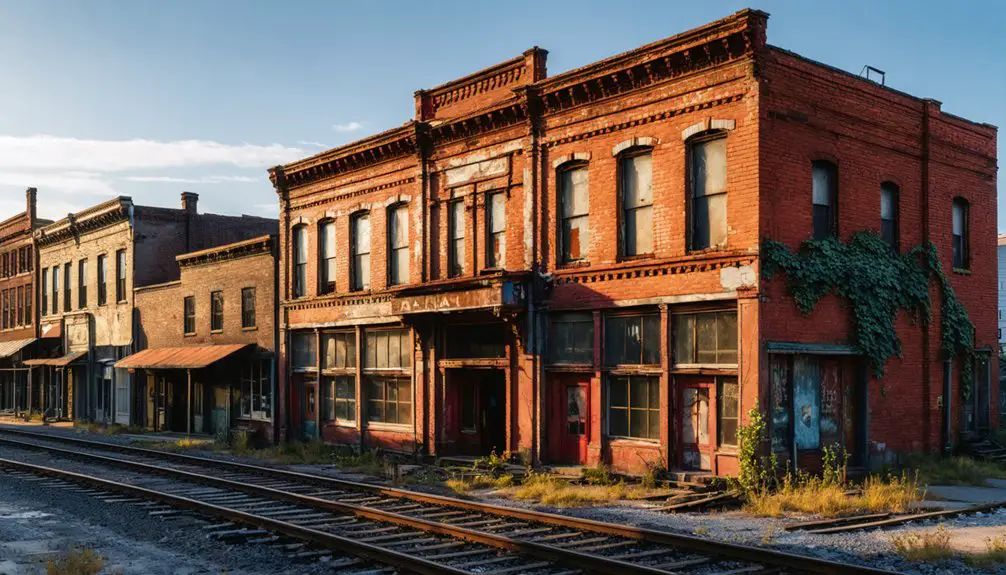
Nestled deep within the New River Gorge, Thurmond’s architectural legacy stands frozen in time, showcasing a remarkably preserved collection of early 20th-century railroad town structures.
You’ll find the architectural style of this once-bustling hub reflected in its wood-framed buildings, ornate cast-iron storefronts, and limestone facades.
Despite preservation challenges like fires and demolitions, the town’s most significant structures endure under National Park Service protection.
- The iconic 1904 C&O Station still serves as an Amtrak stop, bridging past and present
- The four-story Bullock building’s classical revival design speaks to the town’s economic ambitions
- The commissary’s evolution from store to post office reflects the community’s adaptability
- Cast-iron storefronts and limestone detailing reveal the pride of Appalachian craftsmanship
When Steam Engines Stopped Running
The rumble of steam locomotives through Thurmond’s rail yard fell silent in the early 1960s, marking the end of an era that had sustained this mountain town since the 1880s.
You can trace Thurmond’s steam legacy through the dismantling of its iconic infrastructure – the massive water towers, coaling stations, and maintenance shops that once kept the iron horses running.
The shift to diesel locomotives stripped away more than just steam-powered machinery. Nearly 200 workers lost their jobs, triggering a devastating economic decline.
When diesel engines rolled in, they took more than machines – they stole the lifeblood of an entire community.
While the Chesapeake & Ohio Railroad held onto steam power longer than most railways, even they couldn’t resist modernization forever.
Preserving an American Time Capsule
When you visit Thurmond today, you’ll find over twenty original structures carefully preserved by the National Park Service through extensive stabilization efforts that began in 2003.
You can explore the meticulously restored Thurmond Depot, which now serves as a visitor center showcasing the town’s rich railroad heritage through exhibits and guided tours.
The town’s protected status within the New River Gorge National Park guarantees that its authentic early-1900s architecture and industrial character will continue telling the story of America’s coal and railroad era for generations to come.
Historic Architecture Remains Intact
Standing as a remarkable tribute to America’s railroad era, Thurmond’s historic architecture offers visitors an authentic glimpse into early 20th-century life.
The town’s architectural significance shines through its preserved structures, from the Classical Revival limestone facade of the 1917 Bullock Realty building to the historic preservation success story of the 1888 C&O Railroad Station.
- You’ll witness the grandeur of cast-iron storefronts that once housed bustling businesses.
- You can explore the restored railroad station, now serving as both an Amtrak stop and visitor center.
- You’ll discover how the Post Office/Commissary adapted to serve changing community needs.
- You can experience the untouched authenticity of a town that time forgot.
Despite preservation challenges, these surviving structures stand as silent sentinels, telling the story of American industrial might and community resilience.
National Park Service Role
As guardians of Thurmond’s remarkable architecture, the National Park Service faces complex challenges in preserving this American time capsule.
You’ll find they’re balancing historic preservation with public safety and financial constraints at New River Gorge National Park, where deteriorating structures demand difficult decisions.
Through their stewardship challenges, they’ve implemented a thoughtful approach: conducting environmental assessments, gathering public input, and making strategic choices about which buildings to save.
While they’ve had to propose demolition of some structures, you’ll notice they’ve retained key historic buildings like the Marilyn Brown House and Thurmond Ice House.
They’re now offering these preserved structures for lease, encouraging community involvement in rehabilitation efforts.
It’s a delicate balance between maintaining the site’s heritage and ensuring its sustainability for future generations.
Living Railroad Heritage Today
Though many historic railroad towns have vanished into obscurity, Thurmond’s living heritage continues to captivate visitors through its preserved architecture and active rail connection.
You’ll discover a rare glimpse into America’s industrial past, where railroad nostalgia meets modern preservation efforts.
- Watch Amtrak’s Cardinal line make its flag stop at the restored 1995 depot, maintaining a century-old tradition of passenger service.
- Explore the cultural significance of America’s richest coal-era bank town, where fortunes rivaled Cincinnati’s coal throughput.
- Step inside the historic depot-turned-visitor center to experience authentic furnishings and exhibits from the steam rail era.
- Witness preservation in action as local efforts fight to protect 21 endangered historic structures that tell Thurmond’s unique story.
Through determined preservation, you’re free to experience this living museum of American railroad heritage.
Modern Ghost Town Tourism
In recent decades, ghost towns have transformed from forgotten relics into thriving destinations for heritage tourism. You’ll find Thurmond at the forefront of this trend, where unique ghost town experiences attract visitors seeking authentic glimpses into America’s industrial past.
Social media has amplified interest in these abandoned places, drawing photographers and adventurers to capture their haunting beauty.
Instagram and TikTok have turned forgotten ghost towns into must-see destinations, where urban explorers document decay’s mysterious allure.
Tourism sustainability in Thurmond faces both opportunities and challenges. While deteriorating infrastructure poses safety concerns, partnerships between preservation societies and local government help fund restoration projects.
You can now explore the town through guided tours, visit interpretive centers, and support local businesses. The rise of experiential travel and growing interest in Appalachian culture continues to drive tourism growth, though seasonal fluctuations and accessibility issues require careful management to guarantee long-term viability.
Frequently Asked Questions
Are There Any Ghost Stories or Paranormal Activities Reported in Thurmond?
You’ll find ghost sightings around the infamous Dun Glen Hotel site, where visitors report mysterious sounds and shadowy figures. Haunted locations include the old railroad station, where phantom footsteps echo through empty platforms.
What Happened to the Families Who Lived in Thurmond’s Abandoned Homes?
Like pioneers seeking new frontiers, you’d find these families scattered to nearby towns, driven by economic decline in the 1930s. They left their homes behind, searching for work and stability elsewhere.
Can Visitors Stay Overnight in Any of Thurmond’s Historic Buildings?
You can’t stay overnight in any historic buildings, as they’re closed for preservation. While the area offers camping and lodging nearby, the original structures remain protected under National Park Service management.
Is It Legal to Explore and Photograph Abandoned Structures in Thurmond?
While adventurous spirits beckon, you can’t legally enter abandoned structures due to federal property laws. You’re allowed to photograph from public areas, but you’ll need permits for restricted zones.
How Do the Remaining Residents Feel About Tourists Visiting Their Town?
You’ll find positive local sentiments toward tourism, as the five remaining residents actively support visitors. They’ve embraced tourist impact as a way to preserve their town’s heritage and maintain its historic character.
References
- https://www.youtube.com/watch?v=yBKOIRxeNX0
- https://aceraft.com/new-river-gorge/new-river-gorge-national-park/history/history-of-thurmond-west-virginia/
- https://www.youtube.com/watch?v=2x_SbnBKfq4
- https://en.wikipedia.org/wiki/Thurmond
- https://www.nps.gov/neri/learn/historyculture/thurmond.htm
- https://tjpowell.net/2024/06/05/the-history-of-the-thurmond-west-virginia-railroad-bridge/
- https://www.wvencyclopedia.org/entries/688
- https://thurmondwv.org/pages/history
- https://www.nps.gov/articles/thurmond-a-town-born-from-coal-mines-and-railroads-teaching-with-historic-places.htm
- https://theclio.com/entry/21638
